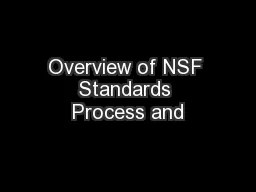

Joint Committee Formation Sustainable Water Contact Products Stakeholder Meeting October 30 2012 Session Overview Brief Overview of NSF International ANSI and NSF Standards Development Process ID: 571531
Download Presentation The PPT/PDF document "Overview of NSF Standards Process and" is the property of its rightful owner. Permission is granted to download and print the materials on this web site for personal, non-commercial use only, and to display it on your personal computer provided you do not modify the materials and that you retain all copyright notices contained in the materials. By downloading content from our website, you accept the terms of this agreement.
Slide1
Overview of NSF Standards Process and Joint Committee Formation
Sustainable Water Contact Products Stakeholder MeetingOctober 30, 2012Slide2
Session Overview
Brief Overview of NSF InternationalANSI and NSF Standards Development ProcessFormation of the Joint Committee
QuestionsSlide3
NSF International: Mission
“Protecting Public Health and SafetyAround the World”
3
Developer of over 72 national consensus standards
Certified
250,000+ products around the
globe
Serve 12,000+ companies in 100
countries including offices
and labs throughout Europe, Asia, Latin America and North AmericaSlide4
U.S. Standardization System
American National Standards Institute (ANSI) A private, non-profit organization that administers and coordinates the U.S. voluntary standardization and conformity assessment systems
ANSI roles
ISO member body for United States
Accreditation of Standard Development Organizations (SDOs)
Process review for voluntary standards development
Accreditation of third-party programs for product certification, personnel accreditation, etc.Slide5
What is a Consensus Standard?
“Consensus” means substantial agreement has been reached by directly and materially affected interest categories. This signifies the concurrence of more than a simple majority, but not necessarily unanimity. Consensus requires that all views and objections be considered, and that an effort be made toward their resolution.
ANSI
Essential RequirementsSlide6
ANSI Ensures Due Process
Due process means that any person (individual, organization, company, etc.) with a direct and material interest has a right to participate by:
Expressing a position and its basis
Having that position considered
Having the right to appealSlide7
ANSI Benchmarks for Due Process
OpennessLack of DominanceBalance of interests
Coordination and Harmonization
Notification of standards activity
Consideration of views and objections
Evidence of consensus
Appeals procedures
Written proceduresSlide8
ANSI-Based Consensus Process
ANSI Project Initiation Notification (PINS)
Development Phase
(Consensus Body)
Ballot and Public Comment Phase
Comment Circulation and/or
Reballot
Reballot
of Substantive ChangesSlide9
NSF Policies Implement
ANSI Due Process RequirementsHow NSF ensures due process in its standards development activities
Operation and structure of NSF standards committees
What points in the NSF process required ANSI notifications take place
Numerical requirements for consensus (balloting)
NSF appeals processSlide10
NSF Standards Credentials
60+ years developing public health and safety standardsANSI accredited standards developer and member of
ANSI leadership committees
ANSI Audited Designator status
Currently maintain
62
American National Standards, another 10
in developmentSlide11
NSF Brings Industry, Public Sector Community, and End Users Together
Federal,
State, Local, Academia
Food, Water, Consumer Goods
Retailers, Media, Educators,
Consumer Groups
End Users
Public
Sector
IndustrySlide12
Consensus body that oversees a specific standard or set of related standards
Balanced membership of external stakeholders
Public Sector/Regulatory
Producers/Manufacturers
End Users/
Specifiers
Other categories as indicated by the standards project
Membership is based on applicant’s experience and expertise (can include international representatives)
NSF Joint CommitteesSlide13
Task Groups
Formed to evaluate a specific technical issue for a Joint Committee (JC)Develop a draft standard, draft revision, or other recommendation for review by the Joint CommitteeMembership not limited to JC members
Ad hoc
or standing group Slide14
Determination of Consensus
Straw ballots and informal comment periodsPilot projects for feasibility“Audit” readiness – objective evidence
Official balloting by NSF Committees and Public Comment Slide15
JC Balloting Requirements
Affirmative ballot of at least 2/3 of those who voted, excluding abstentionsAffirmative ballots must represent at least a simple majority of the JC membership (> 50%)All negative votes or comments have been considered and have received a written response
Unresolved objections have been advised of right to appealSlide16
Council of Public Health Consultants
NSF advisory body for standards developmentElects its own membershipRegulatorsAcademics Public health professionals
Other leadership in public health
No manufacturersSlide17
ANSI Public Review Process
Concurrent with NSF development process
PINS Notification (start of project)
BSR 108 - Draft available for public comment (at JC ballot)
BSR 109 - Final version of standard approved (completion of CPHC ballot)
NSF self-designates as ANSI standardSlide18
Formation of the Joint Committee
Applications are solicited from interested stakeholdersNSF will identify candidate to assume the role of ChairChair must be eligible to provide liaison role to NSF Council of Public Health ConsultantsChair will review applications with NSF to compile balanced committee membership
Applications are maintained for future voting participationSlide19
JC Member ResponsibilitiesProvide technical expertise on one or more subjects covered by a standard
Participate actively by attending meetings, reviewing documents, providing commentsReturn ballots within prescribed deadlinesMinimum 3 year commitmentSlide20
Selection of Voting Members
Individual applications in each interest category will be reviewedEffort to achieve balance within each interest category and across the committeeAny one interest category cannot be more than 50% of the committee membership for non-safety standards
Expertise of individual applicants
An organization can have only one voting member
Slide21
Breakdown of ApplicantsIndustry – 18 applicationsRepresentation across DWTU, DWA, Plastics, Plumbing, RWF and WWT
User – 13 applicationsConsultants, certifiers, professional societyPublic Agency – 6 applicationsLocal, State, Federal government
Additional outreach to public sector, academia neededSlide22
Ways to Participate – Observer
Submittal of public comments on draft standardsObtain copies of drafts and submit public comment for the Joint Committee’s consideration through NSF workspace at http://standards.nsf.org
ANSI
Standards Action
published weekly and available to view at
www.ansi.org
Can attend standards committee meetings (JC or TG) as an observerSlide23
On-line Collaboration Tool
On-line Workspace for standards and policy developmenthttp://standards.nsf.org
Calendar function for meetings – access to logistics and materials
View documents and ballots
Provide comments on documents and ballots
Access to NSF standards development policies and forms, reference materials, etc.Slide24
QUESTIONS?
Thank you!